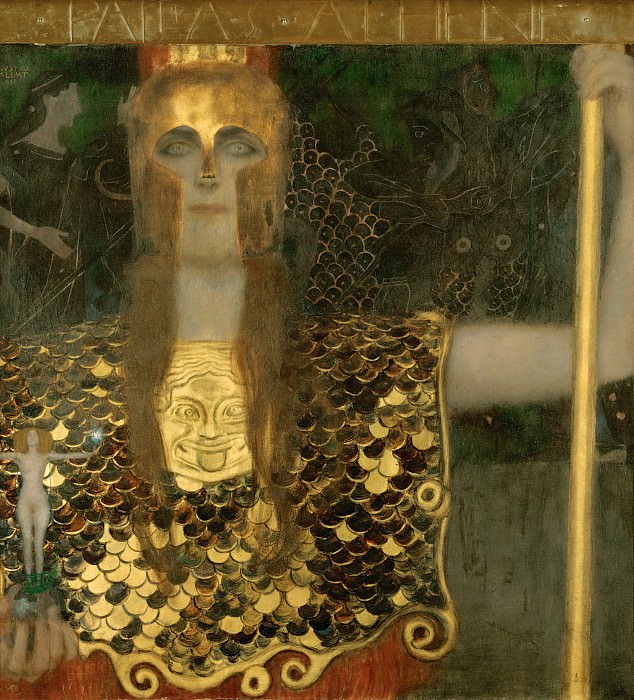Pallas Athene Gustav Klimt (1862-1918)
Gustav Klimt – Pallas Athene
Edit attribution
Download full size: 2625×2900 px (3,3 Mb)
Painter: Gustav Klimt
Location: Wien Museum, Vienna (Wien Museum Karlsplatz, Museen der Stadt Wien).
The distinctiveness of the Austrian artist Gustav Klimt lies in his portrayal of women as the protagonists of his works. In his canvases he touches on such universally significant themes as death, old age, and love, depicted in expressive, eye-catching colors, mostly in gold tones. Especially effective in his canvases are the images of powerful lords and destructive beauties who dominate men and bring them death. The gallery of superwomen begins with Athena Pallada, shown in gold armor, draped in weapons, confident in her victory over all men.
Description of Gustav Klimt’s painting Athena Pallada (1898)
The distinctiveness of the Austrian artist Gustav Klimt lies in his portrayal of women as the protagonists of his works. In his canvases he touches on such universally significant themes as death, old age, and love, depicted in expressive, eye-catching colors, mostly in gold tones. Especially effective in his canvases are the images of powerful lords and destructive beauties who dominate men and bring them death.
The gallery of superwomen begins with Athena Pallada, shown in gold armor, draped in weapons, confident in her victory over all men. Certain details that first emerged on this canvas would later become of paramount importance in the later work of the master, such as the use of noble metal and the metamorphosis of the body into a pattern and the ornament into flesh.
The painting depicts a woman in armor on her chest: strands of long brown hair flowing across her chest emerge from under her helmet, half-hiding her face and head. In her bent and raised hand she holds a metal spear, leaning lightly on it. In the other hand, the character holds the attribute of power in the form of a ball with a miniature nude female figure mounted on it. A chainmail of golden rings is adorned around her neck with a shield with a minted satyr on it. She stands against a wall covered with drawings of the female figure on the left side of the heroine, and on the right is a shaded drawing of a mythical animal against a background of an ornament of rings, echoing the chainmail.
Unlike other beauties in the master’s canvases, Athena exudes power, power-lust, her militancy has a magnetic nature. The brilliance of her armor - the shining helmet, the breastplate of golden rings - correlates with the radiance of her lively, burning eyes, which came to symbolize the Secessionists’ defense of the right to free self-expression. Critics were so impressed with Athena that they gave her the name "Secessionist demon. She launched a new turn in the painter’s works, which was called the golden period. Klimt’s image of Athena captured her divine essence.
Кому понравилось
Пожалуйста, подождите
На эту операцию может потребоваться несколько секунд.
Информация появится в новом окне,
если открытие новых окон не запрещено в настройках вашего браузера.
You need to login
Для работы с коллекциями – пожалуйста, войдите в аккаунт (open in new window).




















You cannot comment Why?
The painting depicts Pallas Athena, the Greek goddess of wisdom and warfare, in a richly decorated, almost surreal manner characteristic of Gustav Klimts style.
What I see:
Subtexts and Interpretations: